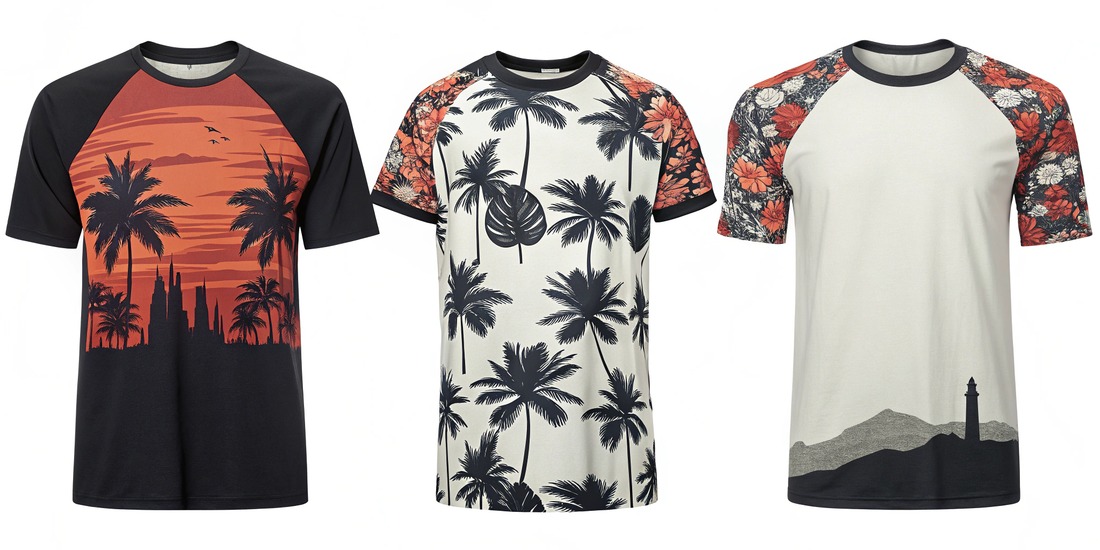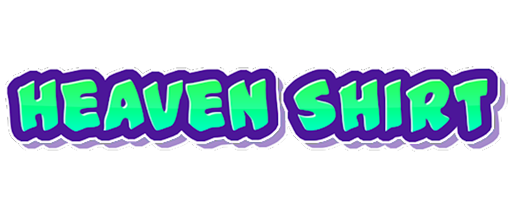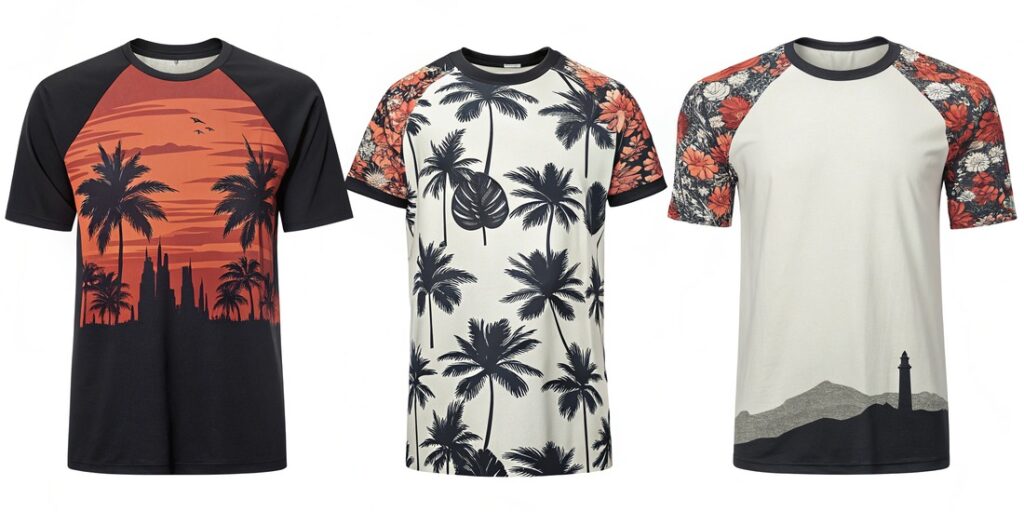LATEST NEWS
Full-Front vs Sleeve Prints Creative T-Shirt Layout Ideas
Full-Front vs Sleeve Prints Creative T-Shirt Layout Ideas

The layout of your t-shirt design determines how people see and interact with your message or artwork. Understanding the differences between full-front vs sleeve print options helps you make smart choices about where to place your graphics for maximum impact. Each placement strategy serves different purposes and creates different visual experiences for both the wearer and the viewer.
Modern t-shirt printing technology has opened up countless possibilities for creative placement options. From traditional chest prints to innovative wraparound designs, today’s printing methods allow for complex layouts that were impossible just a few years ago. This evolution mirrors the advances we’ve seen in t-shirt printing methods and techniques that continue to expand creative possibilities.
Whether you’re designing for personal use, business branding, or retail sales, understanding different print placements helps you create more effective designs. The same attention to detail that goes into creating balanced typography and graphics applies to choosing the right print location for your specific needs.
Understanding Full-Front Print Designs
Full-front prints cover the entire front panel of a t-shirt, creating maximum visual impact and design space. This layout choice works particularly well for complex artwork, detailed illustrations, or designs that need to make a bold statement. When you choose full-front printing, you’re giving your design the largest possible canvas to work with.
The main advantage of full-front vs sleeve print placement is the immediate visibility and impact. People see full-front designs first when looking at someone wearing the shirt. This makes them ideal for branding, promotional messages, or artwork that needs to grab attention quickly. Full-front prints work especially well for band merchandise, event t-shirts, and promotional apparel.
Full-front designs also offer the most flexibility for complex compositions. You can include multiple elements, detailed backgrounds, and intricate graphics that wouldn’t fit well in smaller print areas. This extra space allows designers to create more sophisticated layouts that tell complete visual stories rather than relying on simple graphics or text.
However, full-front prints do come with some considerations. They use more ink and printing resources, which can increase production costs. The larger print area also means more potential for printing issues or quality concerns. Additionally, some people prefer more subtle designs that don’t dominate the entire front of their shirt.
The Appeal of Sleeve Print Designs
Sleeve graphic tees offer a more subtle approach to t-shirt design while still providing visual interest and creative expression. Sleeve prints appear on the upper arm area, creating a design element that’s visible but not overwhelming. This placement works well for people who want to show personality without making their shirt the center of attention.
A sleeve graphic tee provides several unique advantages over traditional front-centered designs. The sleeve location creates a more intimate viewing experience, as people need to be closer to see the design clearly. This can make sleeve prints feel more personal and exclusive, like a secret message or inside joke that only observant people will notice.
Sleeve prints also work well for layering purposes. When you wear a jacket, cardigan, or hoodie over your shirt, sleeve graphics remain visible while front prints get covered up. This makes sleeve graphic tees perfect for transitional weather or professional settings where you might need to layer clothing throughout the day.
The positioning of sleeve prints creates interesting visual balance too. Instead of centering all attention on the chest area, sleeve designs draw the eye to different parts of the shirt. This can be especially flattering for people who prefer not to emphasize their torso area or who want to create more dynamic visual interest.
Exploring Side Print T-Shirt Options
Side print t-shirt designs place graphics along the side seams or lower side areas of the shirt, creating unexpected visual elements that catch people by surprise. This placement option works particularly well for vertical designs, text that reads from bottom to top, or graphics that wrap around the body’s natural curves.
The appeal of a side print t-shirt lies in its unconventional placement that breaks away from expected design locations. When someone wears a side print design, it creates movement and flow that changes depending on how they stand, sit, or move. This dynamic quality makes side prints particularly engaging and memorable.
Side print t-shirt designs work especially well for athletic wear and active clothing. The side placement doesn’t interfere with chest or back movement during exercise, and it creates visual lines that can be flattering for different body types. Many fitness brands use side prints to create designs that look good during movement and at rest.
Typography works particularly well in side print applications. Long phrases, quotes, or brand names can run vertically along the side seam, creating interesting reading experiences that stand out from horizontal text layouts. This vertical orientation also makes efficient use of the shirt’s proportions.
Wraparound Shirt Design Concepts
Wraparound shirt design takes t-shirt graphics to the next level by extending designs around the sides of the shirt or even completely around the garment. This approach creates immersive visual experiences that transform the entire shirt into a canvas for artistic expression.
The most dramatic wraparound shirt design option involves graphics that start on the front, continue around the sides, and connect on the back. This creates a continuous visual experience that makes the shirt itself into wearable art. Landscape scenes, abstract patterns, and narrative illustrations work particularly well with this approach.
Partial wraparound designs offer a middle ground between traditional front prints and full wraparound concepts. These might extend from the front panel onto the sides, or from the back onto the sides, creating visual flow without covering the entire garment. This approach works well for designs that need more space than traditional placement allows but don’t require complete coverage.
Wraparound shirt design works especially well for artistic and creative applications. Musicians, artists, and creative professionals often choose wraparound designs to showcase their work in unique ways. The unconventional placement makes these shirts conversation starters and helps wearers express their creative personalities.
Comparing Full-Front vs Sleeve Print Impact
When weighing full-front vs sleeve print options, consider your design’s primary purpose and intended audience. Full-front prints work best when you need maximum visibility and immediate impact. They’re perfect for logos, promotional messages, or artwork that needs to be seen from a distance.
Sleeve prints excel when you want subtlety and personal expression without overwhelming visual presence. They work well for inside jokes, personal mantras, or designs that create connections between the wearer and observant viewers. The full-front vs sleeve print decision often comes down to whether you want to make a statement or share a secret.
Cost considerations also play a role in the full-front vs sleeve print comparison. Full-front designs typically cost more to produce due to the larger print area and increased ink usage. Sleeve prints usually cost less and can be more budget-friendly for large orders or personal projects.
Durability differences between full-front vs sleeve print placements affect long-term wear and appearance. Full-front prints experience more stress from washing and wearing, while sleeve prints may last longer due to less direct contact with washing machine agitation and daily wear patterns.
Design Considerations for Different Placements
Each print placement option requires different design approaches to achieve optimal results. Full-front designs need to consider the shirt’s natural fold lines and how the design looks when the fabric moves or stretches. Horizontal elements work well for full-front prints, while vertical elements might get distorted.
Sleeve graphic tees require designs that work within the curved, cylindrical shape of the arm. Text needs to be readable from multiple angles, and graphics should maintain their impact even when the arm is in different positions. Consider how the design looks when arms are raised, lowered, or bent.
Side print t-shirt designs must account for the body’s natural curves and how fabric falls along the side seam. Vertical designs often work better than horizontal ones for side placement. The design should look good whether the wearer is standing straight or in casual positions.
Wraparound shirt design requires careful planning to ensure elements align properly when the design continues around the body. Color consistency becomes crucial when prints span multiple fabric panels, and registration must be precise to avoid misaligned elements.
Target Audience and Placement Preferences
Different demographics tend to prefer different print placements based on lifestyle, fashion preferences, and personal style choices. Understanding these preferences helps you choose between full-front vs sleeve print options for specific target markets.
Younger consumers often gravitate toward bold full-front designs that make strong visual statements. These designs align with social media culture where eye-catching visuals perform well in photos and videos. Full-front prints photograph well and create shareable content that appeals to younger demographics.
Professional adults might prefer sleeve graphic tees or side print t-shirt designs that offer personality without overwhelming their overall appearance. These subtler options work better in business-casual environments or situations where understated style is preferred.
Creative professionals and artists often appreciate wraparound shirt design concepts that showcase artistic vision and creative thinking. These individuals typically want clothing that reflects their creative identity and stands out from mainstream fashion choices.
Technical Printing Considerations
Different print placements require different technical approaches and equipment capabilities. Full-front prints need larger printing presses and more setup time, which can affect production schedules and costs. The larger print area also requires more precise color matching and quality control.
Sleeve graphic tee production requires specialized fixtures and techniques to print accurately on curved surfaces. Not all printing facilities have the equipment needed for quality sleeve printing, so availability might influence your decision between full-front vs sleeve print options.
Side print t-shirt production presents unique challenges related to fabric positioning and print alignment. The side seam location requires careful handling to avoid printing over seams or creating uneven coverage. Quality control becomes more complex with side placement.
Wraparound shirt design demands the most sophisticated printing capabilities and setup procedures. Multiple print stations or specialized equipment may be needed to achieve seamless wraparound effects. This complexity typically increases production time and costs.
Color and Contrast Strategies
Print placement affects how colors appear and interact with the shirt’s base fabric color. Full-front designs have the advantage of large color areas that can create dramatic contrast effects. Dark designs on light shirts or light designs on dark shirts both work well with full-front placement.
Sleeve graphic tees require careful color consideration because the arm’s curved surface can affect how colors appear. High contrast combinations work best for sleeve prints to ensure visibility from multiple viewing angles. Subtle color differences might get lost on sleeve placements.
Side print t-shirt designs benefit from bold color choices that stand out against the shirt’s base color. The unconventional placement already draws attention, so colors should support this visual impact rather than blending into the background.
Wraparound shirt design color strategies must consider how colors transition around the body and maintain consistency across different fabric sections. Color gradients and transitions become important design elements that can enhance or detract from the overall effect.
Mixing Multiple Print Placements
Advanced t-shirt designs sometimes combine multiple print placements to create complex, layered visual experiences. You might pair a small front chest print with a larger back design, or combine sleeve graphics with side prints for maximum visual interest.
Combining full-front vs sleeve print elements in a single design requires careful planning to ensure all elements work together harmoniously. The designs should complement rather than compete with each other, creating a cohesive overall appearance.
Multiple placement designs work particularly well for storytelling applications where different print locations contribute to a larger narrative. Event t-shirts, for example, might feature event logos on the front with schedules or maps on the back and sponsor logos on the sleeves.
Cost considerations become more complex with multiple print placements, as each location adds to production expenses. However, the increased visual impact and design sophistication can justify higher costs for special projects or premium apparel lines.
Conclusion
The choice between full-front vs sleeve print placements ultimately depends on your specific design goals, target audience, and intended use for the t-shirt. Full-front designs offer maximum impact and visibility, while sleeve graphic tees provide subtle personality expression. Side print t-shirt options create unexpected visual interest, and wraparound shirt design transforms garments into wearable art.
Each placement strategy has unique advantages and technical considerations that affect both the design process and final results. Understanding these differences helps you make informed decisions that align with your creative vision and practical needs. Whether you choose bold full-front graphics or subtle sleeve details, the key is matching your print placement to your design’s purpose and audience.
Modern printing technology continues to expand placement possibilities, giving designers more creative freedom than ever before. From traditional chest prints to innovative wraparound concepts, today’s t-shirt designers can experiment with layouts that create memorable, engaging apparel that stands out in crowded markets and personal wardrobes alike.
Full-Front vs Sleeve Prints: Creative T-Shirt Layout Ideas
In the world of custom t-shirts, placement is just as important as the artwork itself. Whether you’re designing for personal use, building a brand, or launching your own online t shirts store, choosing between full-front and sleeve prints can completely change the impact of your apparel.
From bold statements to subtle storytelling, every design layout has its place. Let’s explore the pros, cons, and creative possibilities of full-front vs sleeve prints — and how to decide which suits your next t shirt, hoodie, longsleeve, or even ladies t-shirt.
🔥 Full-Front Prints: Bold, Eye-Catching Statements
The full-front print is a staple in both streetwear and casual fashion. It covers the central front area of the shirt, making it the most visible and impactful placement.
✅ Pros:
-
Maximum visibility: Perfect for logos, art, and bold graphics.
-
Ideal for storytelling: Great for funny t shirts, themed designs, or detailed illustrations.
-
Versatile fit: Works well on T Shirts For Men, T Shirts For Women, and ladies t-shirt styles.
❌ Cons:
-
Can feel too loud for minimalist wearers.
-
Heavier designs may affect breathability depending on fabric and print size.
💡 Best Use Cases:
-
Band merch and fandom shirts
-
Pop culture or funny t-shirts
-
Promotional events
-
Fantasy and animal-themed designs
For example, a Cheap T Shirt For Men featuring a dragon vs knight battle or a vintage-style cartoon works beautifully with a full-front layout.
🧵 Sleeve Prints: Sleek, Stylish, and Subtle
Sleeve prints offer a less conventional, more fashion-forward approach to t-shirt design. They’re especially popular in streetwear, skate culture, and high-end urban styles.
✅ Pros:
-
Subtle branding: Great for artists or small businesses.
-
Adds surprise detail: Viewers notice it up close, making it a great second focal point.
-
Works well with layered outfits: Adds flair to a sweater, hoodie, or longsleeve.
❌ Cons:
-
Limited space: You’re working with a narrow, vertical layout.
-
Less visibility: Not ideal for primary graphics or complex art.
💡 Best Use Cases:
-
Typography and slogans
-
Repeated pattern prints
-
Skater, grunge, or minimalist aesthetic
-
Pairing with chest or back designs for a cohesive look
A Funny T Shirt with a main joke on the front and a punchline on the sleeve is a clever way to use this layout creatively.
💥 Combining Both: Multi-Zone Masterpieces
Why choose just one? Many modern t-shirt designs combine multiple placements — full front, sleeve, and even back — for a dynamic and immersive piece of wearable art.
Popular combos:
-
Full-front graphic + sleeve logo
-
Chest badge + full sleeve design
-
Sleeve quote + back print for story-driven shirts
This layered approach is perfect for hoodies, longsleeves, and sweaters, where more canvas space gives designers the freedom to go bold without overcrowding one area.
👕 What Placement Works Best for Your T-Shirt Type?
| Garment Type | Best Layout | Notes |
|---|---|---|
| T Shirts For Men | Full-front or dual-placement | Emphasize bold graphics or humor |
| T Shirts For Women | Sleeve + front/badge combo | Adds elegance and surprise |
| Ladies T-Shirt | Subtle chest/sleeve mix | Feminine cuts pair well with minimalism |
| Hoodie | Sleeve + chest logo | Great for branding and streetwear |
| Sweater | Sleeve details + back text | Adds personality to basics |
| Longsleeve | Full sleeve wrap + front badge | Ideal for layered looks and fashion fans |
🛍️ Final Thoughts: Print Placement That Speaks
Whether you prefer the bold statement of a full-front design or the under-the-radar coolness of a sleeve print, your placement choice should match the energy of your brand or message. As printing technology evolves, the only limit is your creativity.
Need help turning your design idea into a real product? Our T Shirts Store Online offers professional design services and custom printing for cheap t-shirts for men, ladies t-shirts, funny t-shirts, and much more.
Because a great shirt isn’t just about the artwork — it’s about how you wear the story.
You Can See More: Full-Front vs Sleeve Prints Creative T-Shirt Layout Ideas


